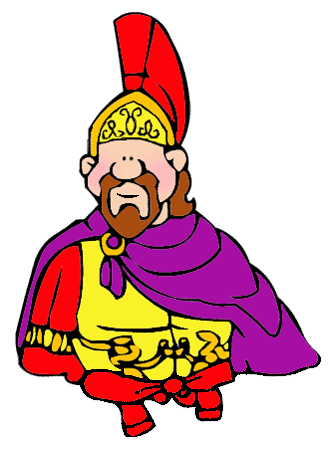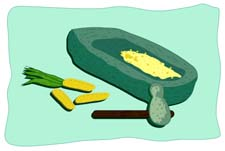|
Medieval Times
Why did the royalty build castles and the nobles dress in armor? What was life like
in the castle as opposed to life in the surrounding village? Children will learn about how people lived, worked and played
in this multi-faceted class. From games and toys to dress and food, we will explore many aspects of life in medieval Europe
and learn about how this time has shaped the world we live in today.
Knight Life
Who were the Knights of Medieval England? What was their lives like? What made a
Knight a Knight and not a squire or peasant? Using the Knight as our guide, this class explores Medieval England through the
eyes of one of its most famous symbols. Children will design and make their own suits of armor, shields, swords and crests
during the course of this five week class. We will also compare the Knights of England with the knights of Japan, a.k.a. the
Samurai, during the same period to learn about how these two groups of elite warriors were similar and different.
Medieval Castles and
Defenses
Imagine that your are a Medieval prince
in Europe in the 1200s. You want what every prince of any standing needs: a castle. During this class children will get the
opportunity to design build and defend their own castle. They will learn about why castles were built, how they were built
and what weapons were used to attack and defend them. What was better, a trebuchet or a catapult? Was one any better? How
did people get inside these fortresses if the gate was closed? These are some of the questions we will be exploring as we
build our Medieval castles.

Ancient Greece
Gods and goddesses, theater, democracy, architecture, the Olympics...for hundreds
of years the Greek culture flourished and has provided us with many of the things we have today. Join us as we build Archimedes'
screw, make pottery, and more!
Ancient Rome
Come along as we explore the games, engineering, mosaics, and Gladiators of
the Ancient Romans. Learn about what happened to the citizens of Pompeii and how this tragedy helps us have a greater
understanding of the Roman people.
Ancient Egypt
What would you take with you on your journey to the afterlife? Make a
mummy, build a pyramid, create a tomb painting and learn Egyptian math as we uncover the mysteries of Egypt.
|
 |
 |
 |
Join us for a guided tour of Plimoth Plantation!
Pilgrims
of Plymouth
Who were the Pilgrims? The Pilgrims
lived right here in our state, having landed in 1620 in Plymouth. In this class, students explore the lives of these founding
mothers and fathers. We explore the reasons why they came to the New World, the difficulties they had in deciding what
to bring, the hardships that 102 people had on board the Mayflower, and what they did after they landed. hands-on activities
allow children to get a better sense of the Pilgrims and learn about how hard it was for these first settlers.
American Revolution
We have all heard about the American Revolution, but what does it all
really mean, where did it happen and why did it happen? In this class, children get the chance to learn the who, what, where,
why and how of the Revolution that gave us the Freedom we so cherish today. Learn what the Boston Massacre was and wasn't,
and why the Founding Fathers chose to put the things they did into the Declaration of Independence. Activities in this
class stress the events that led up to the Revolution (such as the Stamp and Tea Acts) by getting children to place themselves
in the shoes of the Colonists, learning about colonial trading and prices, trades and jobs and how to make a Constitution.
Everyday
Life in the 18th Century
Learn about what children and adults did on a day
to day basis in the 18th century. Students learn about what the typical town was like, and what was important to towns
people in the century of the Revolution. Activities include map making, ink and pen making, games and amusements, jobs and
trades, trading and coinage as well as candle making.
Native Americans of Southeastern Massachsuetts
Native Americans have lived in Southeastern Massachusetts for at least
12,000 years and they continue to live here today, on the land of their forebearers. This class introduces students
to the Wampanoag, the Native people who first interacted with the Pilgrims in the 17th century. Topics covered include clothing,
jobs, games and crafts that these people practiced in the early 17th century. We have designed this class with the intention
of eliminating many of the misconceptions people have about Natives in Southeastern Massachusetts.
|
 |
|
 |
|
 |
|

Shakespeare for Kids
This class explores the works of the Master Poet William Shakespeare, his life, plays
and times. Using Shakespeare as our guide, children will learn more about the plays and the life on the stage in Elizabethan
times. Activities will include: translating portions of Shakespeare’s plays into modern English as a way of understanding
what thee hecketh he talketh about; stage sword fighting; designing advertisements for his plays; and reading and acting out
scenes from his works. It doesn’t matter if your child is outgoing or more reserved, we have parts for everyone. Plays
we will be discussing and using will include but will not be limited to the following: Romeo and Juliet, A Midsummer’s
Night Dream and Julius Caesar.
King Arthur and I
This class is designed for children aged 7 to 12 and explores who King Arthur was
and who he wasn’t. Who was Guinevere and who were the Knights of the Round Table? Was there a Round Table at all? Before
each class, children will be asked to read various stories about King Arthur and his times. Then part of each class will revolve
around a discussion of the story and what it tells us about the King and his adventures. Each class will also include hands
on activities designed to reinforce the concept for that week such as knighthood, chivalry, Arthur and his times, and the
idea of the Hero myth. Children should be ready to read, write and discuss in this exciting new class. The stories that we
will be discussing include but may not be limited to the following: Sir Gawain and the Green Knight; the quest for the Holy
Grail; Merlin; Lancelot; and the Thirteen Treasures of Britain. It’s fun, it’s literature, it’s art and
it’s history all rolled into one class.
Art History
In this class children will explore the history of art and artistic expression from
Prehistoric to Modern Times as we investigate various painting and drawing styles in this very hands-on class. Each session
will focus on a different time period, proceeding in chronological order from cave painting to abstract design. Children will
get the chance to express themselves in the styles of the various times. Participants should be ready to get messy with clay,
paint and chalk.

|
 |
|
|
|